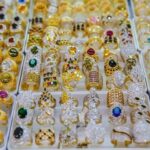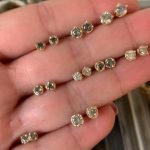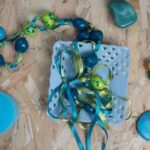Are you looking to add a personal touch to your jewelry pieces? Learn how to make beads for jewelry making and unlock endless creative possibilities. From choosing the right materials and tools, molding and shaping the beads, to adding texture and designs, this introductory section will guide you through the art of creating personalized beads for your jewelry projects.
Making your own beads for jewelry making allows you to express your creativity in unique and beautiful ways. Whether you are a beginner or experienced crafter, understanding the process of bead making can open up a world of possibilities for customization and personalization in your jewelry designs.
In this article, we will explore the materials and tools needed for bead making, the different types of clay suitable for creating beads, step-by-step guides on shaping and molding the beads, tips for adding texture and designs, as well as techniques for painting and finishing the beads. Additionally, we will discuss how to incorporate these handmade beads into stunning jewelry designs that reflect your individual style. Let’s dive into the fascinating world of bead making.
Materials and Tools Needed for Bead Making
When it comes to making beads for jewelry, having the right materials and tools is essential for producing high-quality and unique pieces. The basic materials needed for bead making include clay, a rolling pin, cutting tools, and various shaping tools. Additionally, it’s important to have a work surface that won’t stick to the clay, such as a silicone mat or wax paper.
There are different types of clay that can be used for bead making, each with its own unique characteristics. Polymer clay is a popular choice due to its versatility and ability to hold intricate designs. Air-dry clay is another option that doesn’t require baking in an oven, making it more accessible for beginners.
In terms of tools, a pasta machine can be used to roll out the clay evenly, while various cutters and shaping tools can help achieve different shapes and sizes. Other useful tools include needle tools for creating patterns or textures on the beads, and bead rollers for making uniform round beads.
It’s important to ensure that all materials and tools are kept clean and free from debris in order to produce smooth and flawless beads. By having the right materials and tools on hand, anyone can learn how to make beads for jewelry making and unleash their creativity in designing one-of-a-kind pieces.
| Materials | Tools |
|---|---|
| Clay (polymer clay or air-dry clay) | Rolling pin |
| Cutting tools | Pasta machine |
| Shaping tools | Needle tools |
Choosing the Right Type of Clay for Bead Making
When it comes to making beads for jewelry, choosing the right type of clay is crucial for achieving the desired results. Not all clays are suitable for bead making, so it’s essential to understand the characteristics of different clays and how they will affect the finished product. Here are some popular types of clays used for bead making:
- Polymer Clay: Polymer clay is a versatile and popular choice for making beads. It comes in a wide range of colors, can be easily molded, and is durable once cured. This type of clay is ideal for beginners and experienced bead makers alike.
- Porcelain Clay: Porcelain clay produces delicate and elegant beads with a smooth finish. It’s a bit more challenging to work with due to its fine texture and requires high-temperature firing in a kiln.
- Air-Dry Clay: As the name suggests, air-dry clay dries without the need for baking or firing. It’s a convenient option for those who don’t have access to a kiln or oven, but it may not be as durable as polymer or porcelain clay.
Each type of clay has its own unique properties and working requirements, so consider your skill level, access to equipment, and desired outcome when choosing the right clay for your bead making project.
Once you’ve selected the appropriate type of clay for your beads, it’s important to consider its color, hardness after curing, and any special techniques that may be required during shaping and molding.
Ultimately, the key to successful bead making lies in understanding how each type of clay behaves and experimenting with various techniques to achieve beautiful handmade beads for jewelry making. With patience and practice, you can master the art of using different clays to create unique beads that will enhance your jewelry designs.
Step-by-Step Guide on How to Shape and Mold the Beads
Gathering Your Materials
Before you begin shaping and molding your beads, it’s important to gather all the necessary materials. This includes the clay of your choice, a work surface such as a clay rolling mat or parchment paper, bead rollers or molds, and other shaping tools like needle tools for making holes in the beads.
Preparing the Clay
Start by conditioning the clay to make it pliable and easy to work with. Knead the clay with your hands until it is smooth and free of air bubbles. Once the clay is ready, you can start shaping it into beads using your hands or specific bead-making tools.
Shaping and Molding Techniques
There are various techniques for shaping and molding beads, depending on the style and design you want to achieve. You can use bead rollers to create consistent shapes or experiment with hand-rolling for a more organic look. Additionally, molds can be used to create intricate designs and patterns on the surface of the beads.
When shaping and molding the beads, remember to consider their size, weight, and hole placement if they are intended for stringing onto jewelry. Experiment with different techniques to find what works best for your desired bead designs.
Overall, understanding how to shape and mold beads for jewelry making opens up a world of creative possibilities. Whether you prefer simple geometric shapes or intricate handmade patterns, this step allows you to customize each bead according to your vision for unique jewelry pieces.
Tips for Adding Texture and Designs to the Beads
When it comes to making beads for jewelry, adding texture and designs can take your creations to the next level. Whether you are a beginner or an experienced bead maker, there are various techniques you can use to add visual interest and uniqueness to your beads. Here’s how to make beads for jewelry making with added texture and designs.
One way to add texture to your beads is by using different tools such as toothpicks, needles, or even the edge of a credit card to create patterns or indentations on the surface of the bead. You can also experiment with pressing different materials such as fabric or lace onto the clay before shaping it into a bead to create intricate designs.
Another technique for adding texture and designs is stamping. There are plenty of decorative stamps available in craft stores specifically designed for clay work. These stamps can be used to imprint designs onto the surface of the bead, adding a professional and polished look to your handmade creations.
Additionally, you can incorporate various coloring techniques into your bead making process to enhance the texture and design of the beads. For example, layering different colors of clay, using mica powders, or applying metallic leaf can all create stunning visual effects on your beads.
By incorporating these tips into your bead making process, you can elevate your handmade beads from simple components to unique works of art that will enhance any jewelry design.
| Technique | Description |
|---|---|
| Texturing Tools | Use toothpicks, needles, or other tools to create patterns and indentations on the surface of the bead. |
| Stamping | Utilize decorative stamps designed for clay work to imprint designs onto the surface of the bead. |
| Coloring Techniques | Layer different colors of clay, use mica powders, or apply metallic leaf for stunning visual effects. |
The Importance of Proper Drying and Curing for the Beads
When it comes to making beads for jewelry, proper drying and curing are essential steps in the process. If not done correctly, your beads may not hold up over time and could easily break or crack. Here are some important tips to ensure that your handmade beads are properly dried and cured before using them in your jewelry designs:
- Choose a well-ventilated area for drying: After shaping and molding your beads, it’s crucial to allow them to dry thoroughly before moving on to the curing process. Find a space with good air circulation to help speed up the drying time.
- Use a drying rack or tray: Placing your newly shaped beads on a drying rack or tray will prevent them from sticking to any surfaces as they dry. This will also ensure that they maintain their shape and don’t become misshapen during the drying process.
- Follow the recommended curing time: Depending on the type of clay you’re using, there may be specific instructions for how long your beads need to cure. Pay close attention to these recommendations to avoid any issues with the final quality of your beads.
Properly drying and curing your handmade beads is crucial for creating high-quality jewelry pieces that will last for years to come. By following these important steps, you can ensure that your beads are durable and ready to be incorporated into stunning jewelry designs.
Remember, taking the time to properly dry and cure your beads is just as important as shaping and designing them in the first place. Don’t rush through this step, as it can make all the difference in the final outcome of your handmade jewelry creations. With patience and attention to detail, you can confidently create beautiful beads that are perfect for jewelry making.
Painting and Finishing Techniques for the Beads
Choosing the Right Paint
When it comes to painting handmade beads for jewelry making, it’s important to choose the right type of paint. Acrylic paints are a popular choice for painting beads as they come in a wide range of colors and adhere well to most surfaces. Metallic paints, glitter paints, and special effects paints can also be used to add unique finishes to the beads.
Applying Paint to Beads
Before painting the beads, make sure they are completely dry and cured. Use a small paintbrush or even a toothpick to carefully apply the paint onto the surface of the bead. Take your time and work slowly to ensure even coverage and precise detailing. If you make a mistake, don’t worry – acrylic paint can be easily corrected or removed with water before it dries.
Finishing Techniques
Once the paint is dry, it’s important to protect and seal the beads for longevity. A clear varnish or sealant can be applied over the painted surface of the beads to protect them from wear and tear. This will also give the beads a glossy finish and enhance their colors. Allow the sealant to dry completely before handling or incorporating the beads into jewelry designs.
By using these painting and finishing techniques, you can transform simple handmade beads into stunning, colorful creations that will elevate your jewelry designs. Experiment with different colors, textures, and finishes to achieve unique looks that truly reflect your personal style in your jewelry pieces.
Ideas for Incorporating the Handmade Beads Into Jewelry Designs
Handmade beads can add a unique and personalized touch to your jewelry designs. Once you have mastered the art of making beads for jewelry making, the next step is to explore creative ways to incorporate these handmade beads into your designs. Here are some ideas to get you started:
One way to showcase your handmade beads is by creating a simple yet elegant beaded bracelet. Use a combination of handmade beads in different shapes, sizes, and colors to create a visually appealing design. You can also mix them with commercially-purchased spacer beads and charms to add depth and variety to your bracelet.
Another idea is to use your handmade beads as focal points in necklaces. Combine them with metal findings, gemstone beads, or glass beads to create stunning statement necklaces. Experiment with different bead arrangements and patterns to create a one-of-a-kind piece that reflects your personal style.
If earrings are more your style, consider using your handmade beads to create eye-catching dangle earrings. Pair them with metal or crystal accents for added glamour, or keep it simple with just the handmade beads for a bohemian look.
With the right techniques and creativity, the possibilities for incorporating handmade beads into jewelry designs are endless. Whether you prefer bold and colorful designs or delicate and minimalistic styles, there’s no limit to what you can achieve with your own custom-made beads.
Conclusion
In conclusion, the art of making beads for jewelry offers a world of creative possibilities. By learning how to make beads for jewelry making, individuals can personalize their designs and create unique pieces that showcase their individual style. From choosing the right materials and tools to shaping and molding the beads, every step in the process allows for endless creativity and expression.
The key to successful bead making lies in understanding the importance of proper drying and curing techniques, as well as incorporating texture and designs that add depth and character to each bead. Whether it’s through painting and finishing techniques or experimenting with different types of clay, there are numerous ways to enhance the beauty of handmade beads.
Ultimately, by incorporating personalized beads into their jewelry designs, individuals can create one-of-a-kind pieces that stand out from mass-produced accessories. The satisfaction of wearing or gifting a piece of jewelry adorned with handmade beads is unparalleled, and it serves as a constant reminder of the time and effort invested in creating something truly special.
Aspiring bead makers should not be afraid to explore new techniques and push their creative boundaries – the possibilities are truly endless when it comes to creating personalized beads for jewelry making.
Frequently Asked Questions
How Do You Make Jewelry Beads at Home?
Making jewelry beads at home can be a fun and creative process. You can start by choosing the type of material you want to use, such as polymer clay, glass, or wooden beads.
Then, shape and mold the material into the desired bead shape using tools like a bead roller or mold. Finally, bake or let the beads dry before stringing them into your jewelry piece.
What Are the Ingredients for Bead?
The ingredients for making beads depend on the material you want to use. For example, if you’re working with polymer clay beads, you’ll need polymer clay in various colors, a work surface, cutting tools, and a baking sheet.
If you’re making glass beads, you’ll need glass rods, a torch, kiln, and shaping tools. Wooden beads require wood in different shapes and sizes and sanding tools for a smooth finish.
What Are the Best Beads for Beginners?
For beginners, it’s best to start with larger beads that are easier to handle and manipulate. Pony beads or acrylic beads are great options for beginners due to their size and ease of stringing.
These types of beads come in various colors and shapes, allowing beginners to experiment with different designs without feeling overwhelmed by intricate details or tiny components. As skills improve, beginners can then progress to smaller and more complex bead styles.

Welcome to my jewelry blog! My name is Sarah and I am the owner of this blog.
I love making jewelry and sharing my creations with others.
So whether you’re someone who loves wearing jewelry yourself or simply enjoys learning about it, be sure to check out my blog for insightful posts on everything related to this exciting topic!





